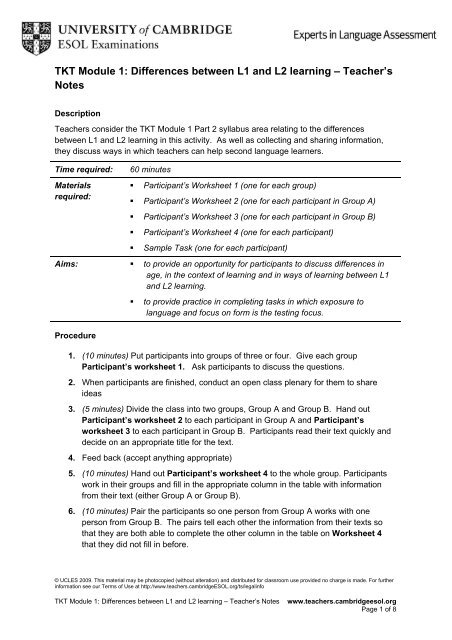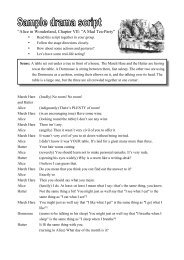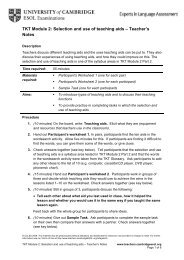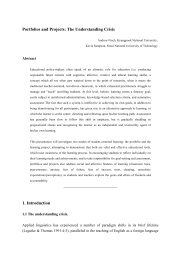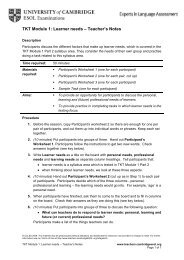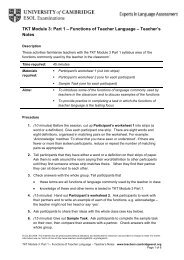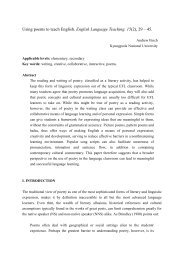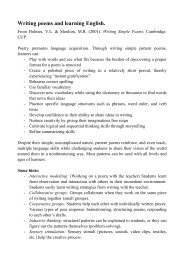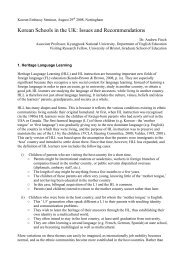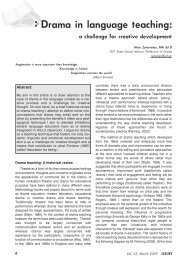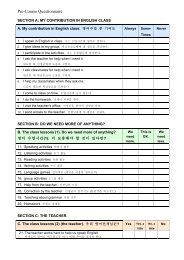Differences between L1 and L2 learning - Finchpark
Differences between L1 and L2 learning - Finchpark
Differences between L1 and L2 learning - Finchpark
Create successful ePaper yourself
Turn your PDF publications into a flip-book with our unique Google optimized e-Paper software.
TKT Module 1: <strong>Differences</strong> <strong>between</strong> <strong>L1</strong> <strong>and</strong> <strong>L2</strong> <strong>learning</strong> – AnswerKeysKey to Procedure Step 81. Find ways to motivate learners <strong>and</strong> to maintain motivation.2. Personalise lessons <strong>and</strong> activities to allow students to talk about themselves <strong>and</strong> theirexperiences.3. Increase students’ exposure to language.4. Ensure that there is interaction in the classroom so that learners can use the language.5. Praise learners.6. Avoid correcting too much.7. Keep teacher language simple.Key to Participant’s worksheet 4Group AFirst language (<strong>L1</strong>) <strong>learning</strong>Group BSecond language (<strong>L2</strong>) <strong>learning</strong>Age Baby, young child Primary, secondary, adultsContext At home Mostly at school in a classroomExposureSurrounded all the timeThree or four hours a week, recordings,texts, the teacher <strong>and</strong> other studentsPraiseCorrection RarelyConstant praise <strong>and</strong>encouragementVaried, depending on the teacherFrequently by the teacherSimplifiedlanguageWay of<strong>learning</strong>Yes, from parentsAcquiring language throughexposureYesAcquiring some through languageexposureInteracting with the teacher <strong>and</strong> otherlearnersDoing controlled practice activities.Motivation Highly motivated Varies – none, a little, a lotSilentperiodLanguageused forYes, sometimes for many monthsTalking about things they seearound themOften notTalking about experiences <strong>and</strong> thingsrelated to lives outside the classroomKey to Sample task1 C 2 C 3 A 4 B 5 B© UCLES 2009. This material may be photocopied (without alteration) <strong>and</strong> distributed for classroom use provided no charge is made. For furtherinformation see our Terms of Use at http://www.teachers.cambridgeESOL.org/ts/legalinfoTKT Module 1: <strong>Differences</strong> <strong>between</strong> <strong>L1</strong> <strong>and</strong> <strong>L2</strong> <strong>learning</strong> – Answer Keyswww.teachers.cambridgeesol.orgPage 3 of 8
TKT Module 1: <strong>Differences</strong> <strong>between</strong> <strong>L1</strong> <strong>and</strong> <strong>L2</strong> <strong>learning</strong> –Participant’s Worksheet 1Discuss the following questions with your group.8. Where <strong>and</strong> when did you start <strong>learning</strong> your second language?9. What do you think is the best age to start <strong>learning</strong> a second language?10. Why do you think is this the best age to start <strong>learning</strong> a second language?11. What do you think are some differences <strong>between</strong> <strong>learning</strong> your first language <strong>and</strong><strong>learning</strong> a second language?12. What do you think are some of the difficulties in <strong>learning</strong> a second language? Arethese the same as the difficulties children have when <strong>learning</strong> a first language?© UCLES 2009. This material may be photocopied (without alteration) <strong>and</strong> distributed for classroom use provided no charge is made. For furtherinformation see our Terms of Use at http://www.teachers.cambridgeESOL.org/ts/legalinfoTKT Module 1: <strong>Differences</strong> <strong>between</strong> <strong>L1</strong> <strong>and</strong> <strong>L2</strong> <strong>learning</strong> – Participant’s Worksheet 1www.teachers.cambridgeesol.orgPage 4 of 8
TKT Module 1: <strong>Differences</strong> <strong>between</strong> <strong>L1</strong> <strong>and</strong> <strong>L2</strong> <strong>learning</strong> –Participant’s Worksheet 2Group A – Text 1Read the text <strong>and</strong> decide on an appropriate title for it.We learn our first language as a baby <strong>and</strong> as a young child <strong>and</strong> continue to build ourlanguage as we grow older <strong>and</strong> learn different kinds of language <strong>and</strong> language skills.Babies <strong>and</strong> children are surrounded by their first language. They hear <strong>and</strong> see their families,friends <strong>and</strong> strangers talking <strong>and</strong> interacting with each other <strong>and</strong> friends <strong>and</strong> family interactwith them. Children are constantly provided with opportunities to use the language <strong>and</strong> toexperiment with the language as they are <strong>learning</strong> it <strong>and</strong> they receive constant praise <strong>and</strong>encouragement for their efforts. Parents encourage <strong>and</strong> persuade their children to talk bysimplifying their own language <strong>and</strong> directing simple questions <strong>and</strong> requesting simpleresponses. When children’s language is inaccurate, adults very rarely correct them or makethem repeat accurate forms <strong>and</strong> they will, more often than not, respond to the utterance in anatural way.Babies <strong>and</strong> children learn language by ‘acquiring’ it through exposure <strong>and</strong> by picking it up.They are generally highly motivated to learn their first language because they have a greatneed <strong>and</strong> desire to communicate with others around them. They hear <strong>and</strong> see friends <strong>and</strong>family communicating with each other <strong>and</strong> they will listen <strong>and</strong> take in this language <strong>and</strong>process it during a ‘silent period’, possibly lasting many months, before using languagethemselves. When children start using language the language they use will be about thingsthey see around them <strong>and</strong> they will play <strong>and</strong> experiment with new language. They learnthrough this experimentation <strong>and</strong> through interaction with family <strong>and</strong> friends.© UCLES 2009. This material may be photocopied (without alteration) <strong>and</strong> distributed for classroom use provided no charge is made. For furtherinformation see our Terms of Use at http://www.teachers.cambridgeESOL.org/ts/legalinfoTKT Module 1: <strong>Differences</strong> <strong>between</strong> <strong>L1</strong> <strong>and</strong> <strong>L2</strong> <strong>learning</strong> – Participant’s Worksheet 2www.teachers.cambridgeesol.orgPage 5 of 8
TKT Module 1: <strong>Differences</strong> <strong>between</strong> <strong>L1</strong> <strong>and</strong> <strong>L2</strong> <strong>learning</strong> –Participant’s Worksheet 3Group B – Text 2Read the text <strong>and</strong> decide on an appropriate title for it.Most people learn their second language at school in a classroom. Some start at primaryschool or secondary school <strong>and</strong> their <strong>learning</strong> might continue in later life. Some people beginsecond language <strong>learning</strong> as adults <strong>and</strong> attend lessons along with the other things they do intheir lives.Second language learners do not usually hear or read more than three or four hours a weekof the second language, so they do not have much exposure to the language. The exposurethey do get is generally in the classroom, where they will hear recordings <strong>and</strong> read texts <strong>and</strong>will have the teacher to listen to. Teachers often simplify their language so are notnecessarily a source of additional exposure to language <strong>and</strong> they usually correct studentsfrequently. In class, the opportunities for second language learners to use the language vary,as does the amount of praise <strong>and</strong> encouragement provided by the teacher <strong>and</strong> otherlearners.Second language learners, like <strong>L1</strong> learners, do learn language by ‘acquiring’ it throughexposure but they are more likely to learn language in a classroom <strong>and</strong> the language theylearn is selected by teachers. They learn by interacting with the teacher <strong>and</strong> with otherlearners <strong>and</strong> by using language in controlled practice activities. In the classroom, learnersoften want to produce the language as soon as possible <strong>and</strong> do not always welcome theopportunity of a silent period. They use language for talking about experiences <strong>and</strong> thingsrelating to their lives outside the classroom. Learning is often dependent on motivation <strong>and</strong>this can vary in second language learners, from learners having little or no motivation tolearners being very highly motivated.© UCLES 2009. This material may be photocopied (without alteration) <strong>and</strong> distributed for classroom use provided no charge is made. For furtherinformation see our Terms of Use at http://www.teachers.cambridgeESOL.org/ts/legalinfoTKT Module 1: <strong>Differences</strong> <strong>between</strong> <strong>L1</strong> <strong>and</strong> <strong>L2</strong> <strong>learning</strong> – Participant’s Worksheet 3www.teachers.cambridgeesol.orgPage 6 of 8
TKT Module 1: <strong>Differences</strong> <strong>between</strong> <strong>L1</strong> <strong>and</strong> <strong>L2</strong> <strong>learning</strong> –Participant’s Worksheet 41. Complete the appropriate column in the table with information from your text.Group AFirst Language (<strong>L1</strong>) <strong>learning</strong>Group BSecond Language (<strong>L2</strong>) LearningAgeContextExposurePraiseCorrectionSimplifiedlanguageWay of<strong>learning</strong>MotivationSilentperiodLanguageused for2. Work with a partner from the other group <strong>and</strong> help each other to complete the othercolumn in the table.3. With your partner, discuss ways of helping second language learners learn. Notedown at least five things that a teacher can do to improve the way second languagelearners learn.© UCLES 2009. This material may be photocopied (without alteration) <strong>and</strong> distributed for classroom use provided no charge is made. For furtherinformation see our Terms of Use at http://www.teachers.cambridgeESOL.org/ts/legalinfoTKT Module 1: <strong>Differences</strong> <strong>between</strong> <strong>L1</strong> <strong>and</strong> <strong>L2</strong> <strong>learning</strong> – Participant’s Worksheet 4www.teachers.cambridgeesol.orgPage 7 of 8
TKT Module 1: <strong>Differences</strong> <strong>between</strong> <strong>L1</strong> <strong>and</strong> <strong>L2</strong> <strong>learning</strong> – SampleTask 1For Questions 1–6, match the aspects of <strong>learning</strong> with the type of learner listed A, B or C.Mark the correct letter (A, B or C) on your answer sheet.You need to use some options more than once.Type of learnerABC<strong>L1</strong> learner<strong>L2</strong> adult learnerBoth <strong>L1</strong> <strong>and</strong> <strong>L2</strong> adult learnerAspect of <strong>learning</strong>1These learners seem to respond to praise <strong>and</strong> encouragement <strong>and</strong> it helps them todevelop their language <strong>and</strong> skills.2These learners don’t need to be constantly corrected. They need to experiment<strong>and</strong> to play with language.3These learners will listen <strong>and</strong> process language <strong>and</strong> will not speak at all,sometimes for many months, before beginning to use language.4These learners are able to share experiences <strong>and</strong> talk about the things they seearound them <strong>and</strong> about experiences in their lives.5 These learners need some controlled practice <strong>and</strong> a focus on form.© UCLES 2009. This material may be photocopied (without alteration) <strong>and</strong> distributed for classroom use provided no charge is made. For furtherinformation see our Terms of Use at http://www.teachers.cambridgeESOL.org/ts/legalinfoTKT Module 1: <strong>Differences</strong> <strong>between</strong> <strong>L1</strong> <strong>and</strong> <strong>L2</strong> <strong>learning</strong> – Sample Task 1www.teachers.cambridgeesol.orgPage 8 of 8


